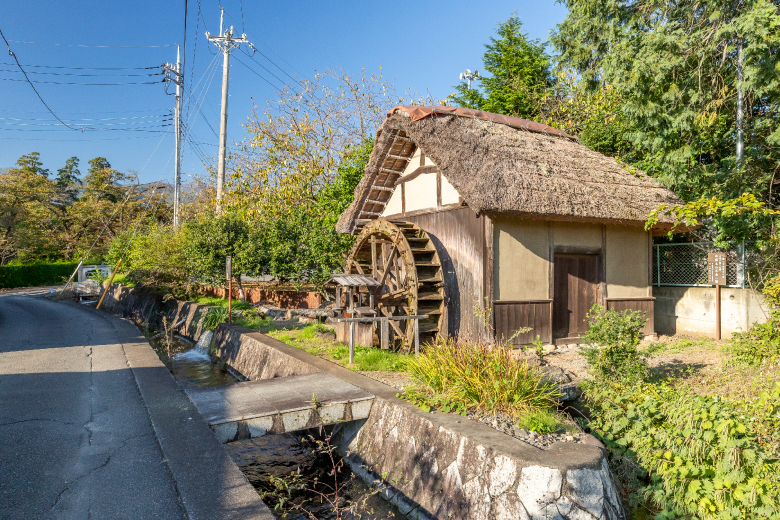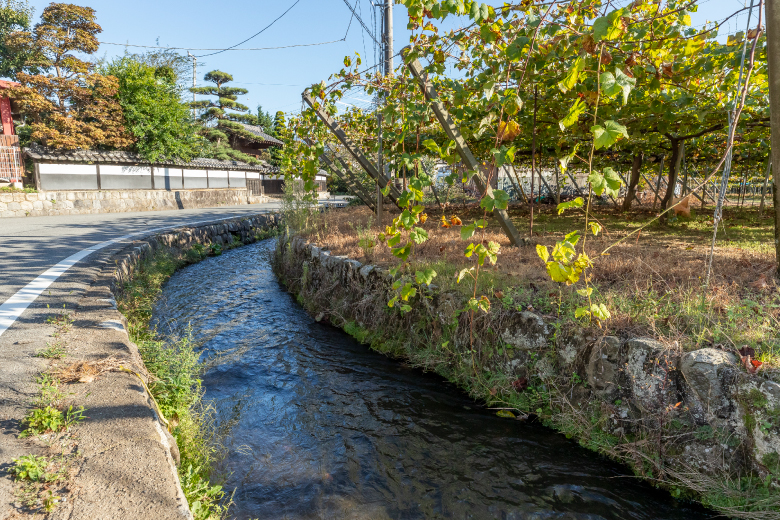Nishifujiki Watermill is an undershot watermill with a wheel directly connected to the Koyashiki-segi Water Channel. Founded in the later Edo Period (1603-1868), it was used as a common watermill of the region before it was placed under the management of Hoko-ji Temple after the war. During the Meiji (1868-1912) and Taisho Periods (1912-1926), there were more than thirty watermills in the Matsusato district, powered by the flow of water through the water channels.
The water channel flowing through this region is called Fujiki-segi Water Channel. Of the three water channels in this region that are fed by Fuefuki River, namely Fujiki-segi, Koyashiki-segi and Ijiri-segi Water Channels, Fujiki-segi is located farthest north. The end of Fujiki-segi had merged with Koyashiki-segi, and the end of Koyashi-segi had in turn merged with Ijiri-segi, to supply abundant water to this region.
The water channel flowing through this region is called Fujiki-segi Water Channel. Of the three water channels in this region that are fed by Fuefuki River, namely Fujiki-segi, Koyashiki-segi and Ijiri-segi Water Channels, Fujiki-segi is located farthest north. The end of Fujiki-segi had merged with Koyashiki-segi, and the end of Koyashi-segi had in turn merged with Ijiri-segi, to supply abundant water to this region.
COURSE MAP
Where to next?
Tracing the backroads of Chichibu and the footsteps of Muso Soseki
A Buddhist priest skilled in garden design (Ishitate-so) – The perspective of Muso Soseki: Stepping deeply into mist along the old road
Deeply intertwined with the history of medieval Japan, Muso Soseki was a Zen monk of the Rinzai Sect who served the Ashikaga shogunate as an advisor during the Muromachi Period (1336-1573). He spent his childhood and trained to become a Buddhist priest in the Kai Region. Kentokusan (Mount Kentoku) was the mountain name (sango) of Erin-ji Temple, where Muso Soseki served as priest. The springs called Ginsho-sui and Kinsho-sui, and a rock for medication (Zazen-seki) remain and can be found on the mountain. Joko-ji Temple, which was located in Makioka Town, Yamanashi Prefecture, is thought to have been established by Muso Soseki after he completed his training.
Besides these, there are many traces of Muso Soseki along the Chichibu Okan Road and in the surrounding areas. It is said that Muso Soseki had as many as 10,000 disciples, and that he was given posthumous Buddhist names by seven emperors and former emperors. Muso Soseki was also skilled in garden design (Ishitate-so). Describing himself as a lover of nature, he had a special fondness for the beauty of fog, cloud, and mist. His aesthetic may have developed as he grew up and trained surrounded by the mountains and fields of the Kai Region.
This route brings visitors to temples that show traces of Muso Soseki, spots related to the Kai-Minamoto Clan and Yasuda Yoshisada, and to the backroads in Chichibu.
Besides these, there are many traces of Muso Soseki along the Chichibu Okan Road and in the surrounding areas. It is said that Muso Soseki had as many as 10,000 disciples, and that he was given posthumous Buddhist names by seven emperors and former emperors. Muso Soseki was also skilled in garden design (Ishitate-so). Describing himself as a lover of nature, he had a special fondness for the beauty of fog, cloud, and mist. His aesthetic may have developed as he grew up and trained surrounded by the mountains and fields of the Kai Region.
This route brings visitors to temples that show traces of Muso Soseki, spots related to the Kai-Minamoto Clan and Yasuda Yoshisada, and to the backroads in Chichibu.
about 40 km / about 6.0 hours / Car

